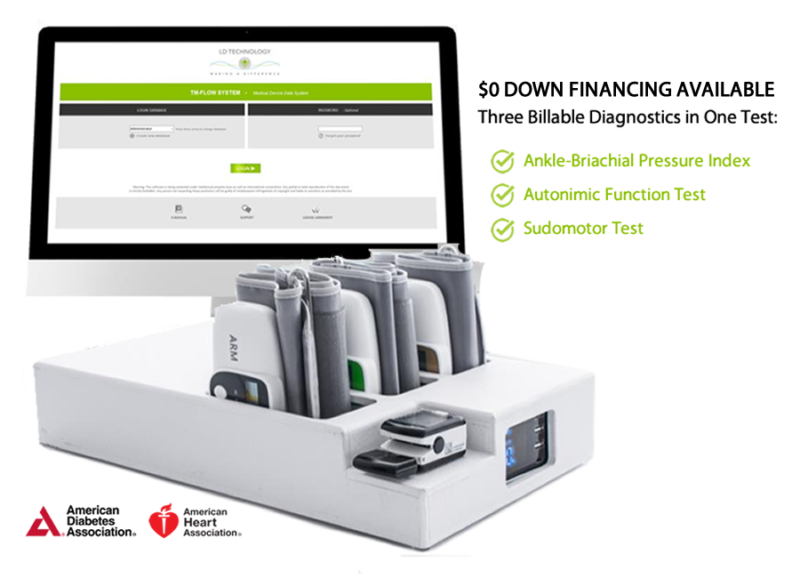Frequently Asked Questions
The TM Flow device offers numerous benefits for medical practices, including non-invasive and accurate testing, early detection of autonomic and arterial dysfunctions, and comprehensive diagnostics that reduce the overall cost of patient care. Additionally, the device’s tests are easy to bill with multi-code diagnostics, making it a valuable investment for enhancing patient care and optimizing practice efficiency. It also supports compliance with standards of care recommended by leading health organizations.
Yes, the TM Flow device is covered by Medicare and most private pay carriers. Specific CPT codes, such as 95921 for cardiovagal innervation and 93923 for ankle-brachial pressure index, ensure that the diagnostics are easy to bill. Coverage and reimbursements may vary depending on the Medicare locality, but the comprehensive diagnostics offered by the TM Flow device are widely recognized and supported by insurance providers.
Autonomic nervous system testing is crucial for diabetes and cardiovascular patients because it helps in the early detection of autonomic neuropathy, which is a common complication in these conditions. Early detection through ANS testing allows for timely intervention and management, reducing the risk of further complications. The American Diabetes Association recommends ANS testing as a standard of care for patients with Type 1 and Type 2 diabetes, highlighting its importance in effective diabetes management.
The TM Flow device is an advanced, non-invasive diagnostic tool designed to perform a series of tests that aid in the identification and early detection of autonomic nervous system (ANS) and arterial dysfunctions. It provides quantitative assessments of the ANS, helping to distinguish between early and late stages of autonomic neuropathy. The TM Flow device is particularly valuable for cardiovascular and diabetic autonomic neuropathy (DAN) testing, making it an essential tool in diabetes management and cardiovascular assessments.

TM Flow in Detroit
Diabetic neuropathy is a common complication of diabetes. Neuropathy affects 25% of type 2 diabetics and 50% of type 1 diabetics. Diabetic neuropathy can be painful and debilitating, but getting tested regularly can help you get treatment early enough to prevent complications. The number of people living with diabetes in Michigan is rising sharply—in part because better diagnosis and treatment have made it possible for people with diabetes to live longer lives than ever before. Peripheral neuropathy symptoms include tingling, numbness, burning feet and other sensations. Annual wellness visits are already covered by Medicare, making it easy for doctors to use TM Flow for diabetic neuropathy testing. Sudomotor testing is a simple, noninvasive screening method that can help doctors diagnose peripheral neuropathy early enough to prevent complications like foot ulcers from happening later on down the road! Early diagnosis and treatment can make a big difference in reducing pain and controlling diabetes better
Diabetic neuropathy is a common complication of diabetes.
Diabetic neuropathy is a common complication of diabetes. It affects one in four people with diabetes, according to the American Diabetes Association (ADA). The condition can cause symptoms such as numbness, tingling and pain in the feet and hands.
The diagnosis of diabetic neuropathy is difficult because symptoms are not specific to the disease and may be similar to other conditions like carpal tunnel syndrome or fibromyalgia. However, there are tests that can help your doctor make a diagnosis including nerve conduction studies and electromyography (EMG).
If you suspect you have this condition, don’t hesitate to speak up! It’s important that we pay attention so we can keep ourselves healthy—and thriving—in our communities.
Neuropathy affects 25% of type 2 diabetics and 50% of type 1 diabetics.
According to the National Diabetes Information Clearinghouse, diabetic neuropathy affects 25% of type 2 diabetics and 50% of type 1 diabetics. While there are many symptoms associated with this type of nerve damage, it’s important to see your primary care provider as soon as possible if you experience any peripheral nerve damage. Peripheral nerves can be damaged by high blood sugar levels or when diabetes damages the small blood vessels in your feet and legs. This can cause pain, numbness or tingling sensations in the hands or feet that may be temporarily relieved by stretching out your muscles (a good reason to get up from sitting for long periods).
Diabetic peripheral neuropathy symptoms include:
- Painful tingling or burning sensations in the toes and bottom of the feet (known as “parathesias”)
- Loss of feeling for touch, temperature changes and vibration (dysesthesia)
- Prolonged sensations such as pins-and-needles sensation even after moving an affected limb away from a source of stimulation
- Unpleasant feelings such as “walking on glass shards” when walking barefoot on a hard floor In addition to these unpleasant symptoms, you should also see your doctor because diabetic peripheral neuropathy is associated with several other serious complications including foot ulcers leading to amputation (see below), gastroparesis which makes it difficult for food digest properly leading to malnutrition/weight loss over time,”
Diabetic neuropathy can be painful and debilitating, but getting tested regularly can help you get treatment early enough to prevent complications.
Diabetic neuropathy is a common and painful complication of diabetes. It affects 25% of type 2 diabetics and 50% of type 1 diabetics, and can be very debilitating. Many people with chronic pain from diabetic neuropathy don’t know how to treat it because they don’t know what’s causing the pain in the first place.
There are several things that you can do to help prevent diabetic neuropathy and treat it if you already have it:
- Get tested regularly for microalbuminuria (protein in your pee) or other symptoms of early kidney damage by your primary care provider; this will help detect problems before they become serious enough to cause organ damage
- Track your blood sugar levels as often as possible using a home monitoring device—this lets you get an idea where they’re going compared with normal values, so if something seems off, you know there might be something else going on that could affect your health
The number of people living with diabetes in Michigan is rising sharply.
Diabetes is a serious condition that requires ongoing care and monitoring. According to the American Diabetes Association, diabetes is the seventh leading cause of death in the US and affects nearly 26 million Americans.
In Michigan alone, more than 500,000 people have been diagnosed with either type 1 or type 2 diabetes—and this number continues to rise dramatically each year. The prevalence of diabetes has increased by over 30 percent in just two decades (from 1993-2013), with many experts now projecting that there will be almost 800,000 new cases diagnosed within another four years (by 2017). As such, it’s crucial for you—and your loved ones—to learn how to manage your condition properly so as not only avoid becoming diabetic yourself but also help those who already are manage their symptoms while reducing their risk factors for complications down the road…
Peripheral neuropathy symptoms include tingling, numbness, burning feet and other sensations.
Symptoms include tingling, numbness and burning sensations in the feet and hands. They may be constant or intermittent. The severity of symptoms can range from mild to severe and may affect one or both feet and/or hands, legs and/or arms.
Annual wellness visits are already covered by Medicare, making it easy for doctors to use TM Flow for diabetic neuropathy testing.
Since Medicare is already covering annual wellness visits for their patients, it’s a no-brainer for doctors to use the TM Flow diabetic neuropathy test. The sudomotor testing technology makes testing simple, fast and accurate.
Sudomotor testing is a simple, noninvasive screening method that can help doctors diagnose neuropathy early enough to prevent complications.
Sudomotor testing is a simple, noninvasive screening method that can help doctors diagnose neuropathy early enough to prevent complications. With results available in minutes and the ability to identify if you have diabetic neuropathies such as tingling or numbness in your hands and feet, TM Flow gives you the tools you need to take charge of your health. It also makes it easy for primary care providers to recommend TM Flow tests.
Early diagnosis and treatment can make a big difference in reducing pain and controlling diabetes better.
The good news is that there are many ways to control diabetes. Treatment can be painful and uncomfortable, but it’s worth it for the health benefits and for reducing your risk of complications. Your physician will help you decide which treatment option is best for you based on your medical history and current condition.
Early diagnosis and treatment can make a big difference in reducing pain, controlling diabetes better, feeling better and preventing complications like kidney disease or eye problems that cause vision loss or blindness
TM Flow’s sudomotor testing technology makes testing simple, fast and accurate.
The TM Flow system is a noninvasive diagnostic tool that measures the sudomotor response. The test is simple, fast and accurate.
TM Flow uses special sensors to measure sweat production in the skin of your fingertips or palms to determine if you are properly hydrated. The results are displayed on-screen in real time, providing immediate interpretation that helps guide decisions about fluid intake and consumption.
TM Flow was developed at the University of Michigan by researchers who have more than 20 years of experience developing neurological diagnostics tools.
TM Flow was developed at the University of Michigan by researchers who have more than 20 years of experience developing neurological diagnostics tools. The technology behind TM Flow has been used to develop a range of products for treatment of neurological disorders, including Parkinson’s disease.
There is a way to find out if you have diabetic neuropathy early enough to stop it from causing problems for you.
There is a way to find out if you have diabetic neuropathy early enough to stop it from causing problems for you. It’s called TM Flow and it’s a simple, noninvasive screening method that can help doctors diagnose neuropathy early enough to prevent complications.
Early diagnosis and treatment can make a big difference in reducing pain and controlling diabetes better.
Conclusion
We hope this article has answered some of your questions about TM Flow and how it can help you prevent diabetic neuropathy complications. If you have any additional questions, we would love to discuss them with you. Please call us at (800) 123-4567 or visit our website at www.tmflow.com/diabetes
RSS FEED
- The TM Flow is a highly reimbursable diagnostic in Portland, OR
- Pain Clinics in Albuquerque, NM Adopt the TM Flow as Gold Standard
- Neuropathy in Philadelphia, PA can be detected with the TM Flow device
- Pain Management Clinics in Dallas, TX are Using the TM Flow to Diagnose Symptoms
- Unlocking the Potential of ANS Testing: Insights for Healthcare Providers
- Neuropathy clinics in Savanah, GA use the TM Flow
- Come to Charleston, WV to Get a TM Flow
- How the TM Flow will maximize your physician practice in Boise Idaho
- Doctors in Pittsburg, PA are using the TM Flow for the treatment of neuropathy
- Which Patients Require ANS Testing?
